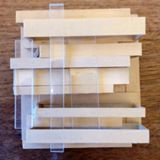Let the prototyping begin
Back in the late 90s when I was in graduate school for architecture at Harvard, I took a class in Prototyping and manufacturing. It was taken with Kimo Giggs and Ken Kao, two great Architects and makers (sadly Ken passed away not too long ago). We were to design something through a prototyping process, designing through a series of iterations starting at a small scale and slowly solving issues as the scale of the prototype grew, and the materials became more real. The class looked at a variety of making processes but the final project is with sticks with me.
My first idea was to create a better paddle for kayaking. I chose this project because I recently gone kayaking with a couple friends (great kayaking, awful raining camping). After some research I realized there was so much already done in the area of paddle design that what I would be able to accomplish would do little to advance paddle design. Instead, I made something that would solve an issue I had relating to the making of computer drawings. It was funny and a bit bizarre. It was called the Trouser Mouse.
The Trouser Mouse, named on a dare from my friend Mike Samra, was a rethinking of how we worked with a computer. As architecture students we would often spend 8-12 hours a day at our computers. Needless to say, this repetitive work could hurt sometimes. This pain was the problem I wanted to find a solution for, and what I was trying to respond to with my product. I felt that the location of the computer mouse itself, on the desk, was not ergonomic. Resting on a desk my arm was at an odd height and angle. My hand/wrist/arm wanted to naturally rest in my lap. I set out to move the mouse to my lap and thereby eliminate the pressure placed on my hand, wrist, and forearm...and so I set out to design a mouse pad that affixed to your leg, lowering the arm...and so the name Trouser Mouse. Sadly no images remain of my exploration, although I can say that the final product worked well and its presentation brought about much laughter.
First three small scale models. A shoebox makes for good material and a place to keep the models afterwards.
With this project I am going to prototype, design, and build something I have been thinking about for decades: a chair. In that time it was not a specific chair but many sketches. The chair seems to me one of the most direct and humanly scaled of all designed problems. Everybody comes in direct contact with the chair and it's comfort is essential. There is not much room for error and the challenges are large.
The parameters for my design for the following:
One. The chair must accommodate an adult human being
Two. The chair must be made of two materials, wood and some sort of woven element, which could be cane or rope. (Or other?)
Three. The frame or some portion of the chair must be cut on a CNC machine in it's final production.

